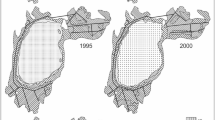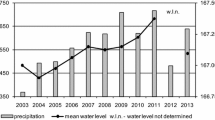Abstract
The hydrochemical regime and the biota in two lakes of Vooremaa landscape protection area, Central Estonia, were studied in 2000–2001 within the frames of the EC project ECOFRAME aimed to work out water quality criteria for shallow lakes in Europe. Lake Prossa is a macrophyte-dominated lake with an area of 33 ha and a mean depth of 2.2 m. Most of the bottom in this lake is covered by a thick mat of charophytes all the year round. Lake Kaiavere located at a distance of 10 km from the former is a much larger (250 ha, mean depth 2.8 m) plankton-dominated lake. Despite the different area and the Chara meadows in Lake Prossa, the nutrient dynamics were very similar in both lakes. The first vernal phytoplankton peak was expressed in reduced Secchi depth in both lakes. After that peak, the water became clear in L. Prossa but remained turbid in Lake Kaiavere. In the Chara-lake the mean individual weight of zooplankton reached its maximum in both years in June. In the year 2000 it coincided with the peak of the zooplankton/phytoplankton ratio and with the minimum of soluble reactive phosphorus both contributing to the initiation of the clear-water period. Towards autumn, the individual mean weight of zooplankton decreased in the Chara-lake and remained smaller than in the plankton-dominated lake. Hence, zooplankton grazing could initiate the clear-water phase in the Chara-lake but other factors were needed for its maintenance. Another parameter that showed a clear difference between these two lakes was the carbonate alkalinity. It was rather stable or even increasing during spring in the plankton-dominated lake, while it decreased by nearly 50% between April and July in the Chara-lake. The calculated saturation level of calcite remained still lower in the Chara-lake showing that the co-precipitation of algae with autochthonous calcite could not explain the observed increase in water transparency above Chara meadows. The reduced sediment resuspension and the possible allelopathic influence of charophytes on phytoplankton remain the main explanations for the maitenance of the extensive clear-water period in the Chara-lake.
Similar content being viewed by others
References
Balls, H., B. Moss & K. Irvine, 1989. The loss of submerged plants with eutrophication. I. Experimental design, water chemistry, aquatic plant and phytoplankton biomass in experiments carried out in ponds in the Norfolk Broad. Freshwat. Biol. 22: 71–87.
Blindow, I., A. Hargeby, B. M. A. Wagner & G. Andersson, 2000. How important is the crustacean plankton for the maintenance of water clarity in shallow lakes with abundant submerged vegetation? Freshwat. Biol. 44: 185–197.
Grasshoff, K., M. Ehrhaedt & K. Kremling (eds), 1982. Methods of Seawater Analysis. ISBN, Verlag Chemie, Weinheim: 419 pp.
Gross, E., D. Erhard & Iványi, 2003. Allelopathic activity of Ceratophyllum demersum L. and Najas marina spp. intermedia (Wolfgang) Casper. Hydrobiologia 506–509: 583–589.
Irvine, K., B. Moss & H. Balls, 1989. The loss of submerged plants with eutrophication. II. Relationships between fish and zooplankton in a set of experimental ponds, and conclusions. Freshwat. Biol. 22: 89–107.
Jeppesen, E., Ma. Søndergaard, Mo. Søndergaard & K. Christoffersen (eds), 1998. The Structuring Role of Submerged Macrophytes in Lakes. Ecological Studies. Vol. 131. Springer, New York: 423 pp.
Kisand, A. & P. Nõges, 2003. Sediment phosphorus release in phytoplankton dominated versus macrophyte dominated shallow lakes: importance of oxygen conditions. Hydrobiologia 506–509: 129–133.
Koschel, R., J. Benndorf, G. Proft & F. Recknagel, 1983. Calcite precipitation as a natural control mechanism of eutrophication. Arch. Hydrobiol. 98: 380–408.
Koschel, R., B. Giering, P. Kasprzak, G. Proft & H. Raidt, 1990. Changes of calcite precipitation and trophic conditions in two stratified hardwater lakes of the Baltic Lake District of the GDR. Verh. int. Ver. theor. angew. Limnol. 24: 140–145.
Lauridsen, T., L. J. Pedersen, E. Jeppesen & M. Søndergaard, 1996. The importance of macrophyte bed size for cladoceran composition and horizontal migration in a shallow lake. J. Plankton Res. 18: 2283–2294.
Meijer, M.-L., 2000. Biomanipulation in the Netherlands. 15 years of experience. Thesis, Wageningen University, Wageningen: 208 pp.
Moss, B., H. R. Balls, K. Irvine & J. Stansfield, 1986. Restoration of two lowland lakes by isolation from nutrient-rich water sources with and without removal of sediment. J. Appl. Ecol. 23: 391–414.
Moss, B., J. Stansfield, K. Irvine, M. R. Perrow & G. Phillips, 1996. Progressive restoration of a shallow lake – a 12-year experiment in isolation, sediment removal and biomanipulation. J. Appl. Ecol. 33: 71–86.
Pluntke, T. & H.-P. Kozersky, 2003. Particle trapping on leaves and on the bottom in simulated submerged plant stands. Hydrobiologia 506–509: 575–581.
Pokorny, J., J. Kvet, P. Ondok, Z. Toul & I. Ostry, 1984. Productionecological analysisof a plant community dominated by Elodea canadensis. Aquat. Bot. 19: 263–292.
Ruggiero, A., A. G. Solimini & G. Carchini, 2003. Nutrient and chlorophyll a in eutrophic mountain ponds with contrasting macrophyte coverage. Hydrobiologia 506–509: 657–663.
Scheffer, M., 1998. Ecology of shallow lakes. Chapman & Hall, London: 357 pp.
Simm, H., 1975. Eesti pinnavete hüdrokeemia. Valgus, Tallinn: 200 pp.
Søndergaard, M., 1988. Seasonal variation in the loosly absorbed phosphorus fraction of the sediment of a shallow and hypertrophic lake. Environ. Geol. Wat. Sci. 11: 115–121.
Søndergaard, M., J. P. Jensen & E. Jeppesen, 2003. Role of sediment and internal loading of phosphorus in shallow lakes. Hydrobiologia 506–509: 135–145.
Søndergaard, M. & B. Moss, 1998. Impact of submerged macrophytes on phytoplankton in shallow freshwater lakes. In Jeppesen, E., Ma. Søndergaard, Mo. Søndrgaard & K. Christoffersen (eds) The Structuring Role of Submerged Macrophytes in Lakes. Ecological Studies. Vol. 131. Springer, New York: 115–132.
Starast, H. & H. Simm, 1973. Hüdrokeemiline re?ziim. In Timm, T. (ed.), Võrtsjärv. Valgus, Tallinn: 61–74.
Timms, R. M. & B. Moss, 1984. Prevention of growth of potentially dense phytoplankton populations by zooplankton grazing in the presence of zooplanktivorous fish in a shallow wetland ecosystem. Limnol. Oceanogr. 29: 472–486.
Utermöhl, H., 1958. Zur Vervollkommnung der quantitatieven Phytoplankton-Methodik. Mitteil. int. Ver. theor. angew. Limnol. 9: 1–38.
Van den Berg, M. S., 1999. Charophyte colonization in shallow lakes: processes, ecological effects and implicationsfor lake management. Thesis, Free University, Amsterdam: 138 pp.
Van den Berg, M. S., H. Coops, M.-L. Meijer, M. Scheffer & J. Simons, 1998. Clear water associated with dense Chara vegetation in the shallow and turbid lake Veluwemeer, The Netherlands. In Jeppesen, E., Ma. Søndergaard, Mo. Søndrgaard & K. Christoffersen (eds.), The Structuring Role of Submerged Macrophytes in Lakes. Ecological Studies. Vol. 131. Springer, New York: 339–352.
Van Donk, E. & W. J. van de Bund, 2002. Impact of submerged macrophytes including charophytes on phyto-and zooplankton communities: allelopathy versus other mechanisms. Aquat. Bot. 72: 261–274.
Wetzel, R., 1960. Marl encrustation on hydrophytes in several Michigan lakes. Oikos 11: 223–236.
Author information
Authors and Affiliations
Rights and permissions
About this article
Cite this article
Nõges, P., Tuvikene, L., Feldmann, T. et al. The role of charophytes in increasing water transparency: a case study of two shallow lakes in Estonia. Hydrobiologia 506, 567–573 (2003). https://doi.org/10.1023/B:HYDR.0000008625.36438.75
Issue Date:
DOI: https://doi.org/10.1023/B:HYDR.0000008625.36438.75




